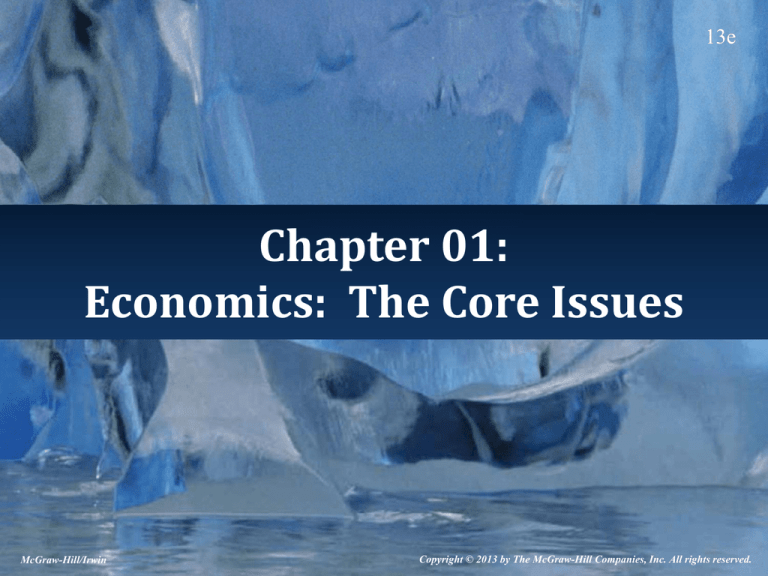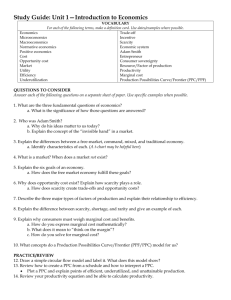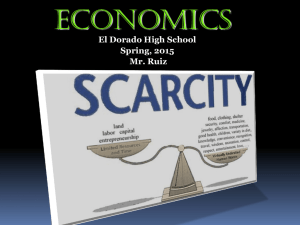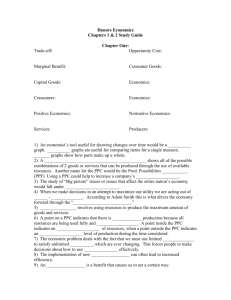
13e
Chapter 01:
Economics: The Core Issues
McGraw-Hill/Irwin
Copyright © 2013 by The McGraw-Hill Companies, Inc. All rights reserved.
The Goals of This Course
• To understand how the economy really works.
• To determine how markets shape economic
outcomes.
• To examine the role that government can and
does play in (re)shaping economic
performance.
• To understand how we ourselves can make
better economic decisions.
1-2
Learning Objectives
• 01-01. Know how scarcity creates
opportunity costs and forces economic
choices.
• 01-02. Know what the production
possibilities curve represents.
• 01-03. Know the three core economic
questions that every society must answer.
• 01-04. Know how market and government
approaches to economic problems differ.
1-3
The Core Issues
• The purpose of an economy is to produce
goods and services that satisfy peoples’
wants using the limited resources available.
• There are three core choices that confront
every nation:
– WHAT to produce with our limited resources.
– HOW to produce the goods and services we
select.
– FOR WHOM goods and services are produced –
that is, who should get them.
1-4
What Is the Economy?
• The economy is us.
• It is the grand sum of all our production and
consumption activities.
• For the United States, it is the collective
behavior of the 310 million individuals who
participate in it.
• Economics: the study of how best to allocate
scarce resources among competing uses.
1-5
Scarcity: The Core Problem
• Scarcity: lack of enough resources to satisfy all
desired uses of those resources.
– There aren’t enough resources available to satisfy
all our desires.
• Scarcity of resources limits the amount of
goods and services that can be produced.
– Somebody’s wants will have to go unfulfilled.
• Whose?
– Scarcity requires economic choices to be made.
• Who will decide?
1-6
Factors of Production
• Factors of production: resource inputs used
in the production of goods and services, the
desired outputs.
• Four types.
– Land – all natural resources.
– Labor – skills and abilities of all humans at work.
– Capital – goods produced for use in further
production.
– Entrepreneurship – the assembling of resources to
produce new or improved products and
technologies.
1-7
Opportunity Cost
• When we choose to use resources to produce
one thing, we must give up producing
something else with those resources. This
trade-off comes with a cost.
• Opportunity cost: the value to you of the next
most desired good forgone to obtain some
other higher-priority good.
– What is given up to undertake a chosen activity.
• Associated with every decision:
– For example, if we choose to produce bread, then
we cannot produce pizza crust with the same flour.
1-8
Production Possibilities
• Production possibilities: the various
combinations of final goods and services
that could be produced in a given time
period with all available resources and
technology.
1-9
Trucks vs. Tanks
• One factory can produce either trucks or
tanks, or some of each with the limited
resources available to it.
• To increase truck production, resources
must be shifted away from tank production,
and vice versa.
– Note the opportunity cost in this trade-off.
1-10
Production Possibilities Curve (PPC)
OUTPUT OF TRUCKS
5
A
Point
A
B
C
D
E
B
4
C
3
D
2
F
E
1
0
1
2
3
4
OUTPUT OF TANKS
F
5
Trucks Change Tanks Change
5
0
4
-1
2.0
+2
3
-1
3.0
+1
2
-1
3.8
+0.8
1
-1
4.5
+0.7
0
-1
5.0
+0.5
Note that as we move from
A to F, each time we give
up the same amount but
get back less and less in
return.
The trade-off gets worse
and worse.
1-11
Law of Increasing Opportunity Costs
• The opportunity cost of producing additional
units of one good increases.
– Each time we give up one truck, we get less back in
tank production.
• Resources are specialized to produce one good
better than another.
– Good tank resources are shifted first.
– Later shifts involve resources less good for tank
production.
– Accounts for the bowed shape of the PPC.
1-12
Law of Increasing Opportunity Costs
OUTPUT OF TRUCKS
5
A
Step 1: give up one truck
B
4
3
2
Step 2: get two tanks
Step 3: give up another truck
C
Step 4: get one more tank
D
E
1
0
1
2
3
OUTPUT OF TANKS
4
5
F
1-13
Production Possibilities Curve (PPC)
• The PPC illustrates two essential principles:
– Scarce resources: there is a limit to the amount
we can produce in a given time with available
resources and technology.
• This limitation positions the PPC.
– Opportunity costs: we can obtain additional
quantities of one of the goods only by reducing
production of another good.
1-14
Surveying Points on the PPC
OUTPUT OF TRUCKS
5
A
X
4
B
3
Y
2
1
0
Points outside the PPC
are unattainable with
available resources and
technology.
C
Points inside the PPC
represent incomplete
or inefficient use of
available resources.
1
2
3
4
5
OUTPUT OF TANKS
Only points on the PPC represent maximum efficient use of our production possibilities.
1-15
Economic Growth
• Economic growth: an increase in output; an
expansion of production possibilities.
– Raises our standard of living.
– Satisfies more wants and needs.
– Creates more jobs.
• Economic growth is caused by increasing the
resources available or by producing better
technology.
– The PPC pushes outward.
1-16
Economic Growth
OUTPUT OF TRUCKS
PPC2
PPC1
X
Either increase resource inputs or
improve technology, or both
(B to X).
B
Put idle resources
to work (Y to B).
0
Y
OUTPUT OF TANKS
First, reach the current PPC by putting idle
resources to work.
Second, add resources or technology to achieve
previously unattainable combinations.
1-17
Three Basic Decisions
• WHAT to produce: the point we choose on the
production possibilities curve determines what
mix of output gets produced.
• HOW to produce: someone must decide which
production methods and technologies to use.
• FOR WHOM to produce: there must be a
mechanism to determine whose wants and
needs will be satisfied and who must go
without.
1-18
The Market
• Adam Smith called it “the invisible hand.”
– It is as if we are “guided” to the correct point on the
PPC.
– In fact, we get there by the interaction of millions of
decisions made by buyers, sellers, and producers in
their own self-interest (i.e., to make themselves
better off).
• We call this the market mechanism:
– The use of market prices and sales to signal desired
outputs and resource allocations.
1-19
The Market
• Here is how the market answers the three
basic questions:
– WHAT to produce? Produce goods and services
that customers want.
– HOW to produce? Profitably; produce an
acceptable good or service while keeping
production costs low.
– FOR WHOM to produce? Produce for those
who are both willing and able to pay for it.
1-20
The Government
• At its extreme, government could dictate
answers to all three questions.
– Such decisions would be made by political leaders
and bureaucrats.
– Most likely these decisions would not mirror the
individual desires of the people.
– The FOR WHOM decision would lean heavily
toward favoritism: goods for those the government
favors and none for those not in favor.
1-21
A Mixture of Both
• The market is highly efficient in production of
wanted goods and services.
• The government acts as a maintainer of
balance in the economy.
– Makes sure the market does not go to excesses
either in underproduction or overproduction.
– Regulates production to ensure that goods and
services are safe.
– Acts to redress excessive inequalities.
1-22
What Mix Is Best?
• Few governments have relied exclusively on
either pure market or pure government to
manage the economy.
• Public opinion around the world indicates that
the free-market economic system is best.
• The Index of Economic Freedom ranks nations
according to economic freedom.
– Market-dominated economies rank high;
government-run economies rank low.
1-23
Market Failure and
Government Failure
• If the market does not produce the mix of
goods that society desires, market failure is
said to occur.
• This provides an opening for government to
step in.
– If government can move us closer to the mix society
desires, the intervention is successful.
• However, government can do the opposite, or
impose such high costs that the market simply
ceases to produce. This is government failure.
1-24
What Economics Is All About
• Society and its leaders set the nation’s
economic goals. Economics focuses on the
means of achieving those goals.
• Macroeconomics will focus on “big picture”
economics while microeconomics will focus
on economic interactions of consumers and
producers.
1-25
Types of Economic Analysis
• Positive analysis in economics focuses on
“what is” and is based on facts.
• Normative analysis focuses on “what should
be” and is based on opinions and judgments.
1-26









